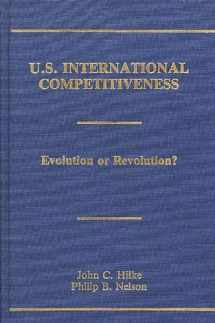
U.S. International Competitiveness: Evolution or Revolution?
ISBN-13:
9780275929640
ISBN-10:
0275929647
Author:
John C. Hilke, Philip B. Nelson
Publication date:
1988
Publisher:
Praeger
Format:
Hardcover
246 pages
FREE US shipping
Book details
ISBN-13:
9780275929640
ISBN-10:
0275929647
Author:
John C. Hilke, Philip B. Nelson
Publication date:
1988
Publisher:
Praeger
Format:
Hardcover
246 pages
Summary
U.S. International Competitiveness: Evolution or Revolution? (ISBN-13: 9780275929640 and ISBN-10: 0275929647), written by authors
John C. Hilke, Philip B. Nelson, was published by Praeger in 1988.
With an overall rating of 3.9 stars, it's a notable title among other
books. You can easily purchase or rent U.S. International Competitiveness: Evolution or Revolution? (Hardcover) from BooksRun,
along with many other new and used
books
and textbooks.
And, if you're looking to sell your copy, our current buyback offer is $0.54.
Description
U.S. International Competitiveness challenges the common assertions concerning causes of America's growing trade deficit. The authors' unique empirical analysis of industry specific trade flows using numerous explanatory variables provides a vigorous test of the view that deficit growth is primarily due to unfair foreign trade practices, overzealous antitrust laws, slack U.S. management, and other microeconomic factors. Their conclusions on the actual culprits offer a sobering reassessment of current and proposed trade policies. American and foreign public policy makers, as well as trade and industrial organization scholars, will find this volume to be enlightening and provocative reading.The first two chapters establish the parameters and theoretical background for the study. The authors then review the microeconomic explanations for sudden trade deficit growth, identify industry characteristics included in the study, and specify the model to be tested. Turning to an examination of the empirical results, they initially look at whether changes in industry characteristics over time could have increased the deficit. They then highlight microeconomic explanations for changes in the U.S. trade balance. Concluding chapters present detailed case studies of particular industries as well as the policy implications to be drawn from the study.


We would LOVE it if you could help us and other readers by reviewing the book
Book review

Congratulations! We have received your book review.
{user}
{createdAt}
by {truncated_author}


